Table of Contents

The Magic of First Encounter
As the lights dimmed in the concert hall and the conductor’s hands paused momentarily in the air, the first notes flowed gently into my ears like the beginning of an ancient tale. Soon, the tempo quickened, and rhythms reminiscent of dancers filled the space, making my feet unconsciously tap along. That was my first encounter with Brahms’ Hungarian Dance No. 6.
This piece wasn’t just a dance composition. It was a vivid story embodying the free spirit of nomads, hidden sorrows, and a passionate zest for life. Today, I invite you to journey with me into the captivating world of this masterpiece.

Brahms and His Encounter with Gypsy Music
Johannes Brahms (1833-1897), though German by birth, drew musical inspiration from various ethnic traditions beyond his homeland’s borders. His Hungarian Dances began as a journey that started in 1850 when, at just 17 years old, he met the Hungarian violinist Eduard Reményi.
In his early twenties, Brahms traveled with Reményi on concert tours and became deeply fascinated by the music of Hungarian gypsies. Their free-spirited performance style, passionate rhythms, and profound emotional depth stimulated the young Brahms’ musical sensibilities.
The Hungarian Dances consist of 21 pieces published in two sets: the first ten in 1869 and the remaining eleven in 1880. Interestingly, Brahms introduced these works as “arrangements” rather than original compositions. Indeed, most pieces were based on Hungarian folk songs or gypsy melodies, with only numbers 11, 14, and 16 being entirely Brahms’ original creations.

Inside the Dance: Movements of Passion
Hungarian Dance No. 6 was originally composed as a piano duet (for four hands on one piano) but is now more widely known in its orchestral version. The piece follows the structure of a traditional Hungarian Csárdás dance, characterized by a transition from a slow introduction to a fast-paced tempo.
First Section: A Melancholic Overture
The dance begins with a slow and elegant introduction. This moment resembles a dancer taking their first pose on stage. Here, Brahms captures the essence of the “Verbunkos,” a recruitment dance characteristic of Hungarian gypsy music. Within this lyrical melody lies a touch of melancholy and nostalgia.
Second Section: An Explosion of Passion
Suddenly, with the marking “Vivace,” the music transforms into a vibrant and passionate atmosphere. This section represents the “Friska” of the Csárdás, characterized by fast tempo and intense rhythm. With rhythms reminiscent of galloping hooves and passionate melodies, the contrasting dynamics between the powerful strings and percussion and the quieter woodwind sections create an intriguing contrast.
Brahms crafts dramatic effects through sudden dynamic changes in this piece. Sometimes whispering quietly, then instantaneously bursting with explosive energy, this dance makes the audience’s emotions rise and fall.
The second theme has a more restrained feeling rooted in Hungarian folk melodies. Brahms creates light and shade within the dance by alternating between sweet melodies and the vibrant second theme. Finally, after a very brief recapitulation of the first theme, the piece concludes with two brilliant chords.

Hungarian Dance in My Heart
When I first heard this piece, I felt as though I were traveling through the fields and villages of 19th-century Hungary. The elegant melody of the introduction evoked the landscape of vast plains, while the passionate rhythm of the fast section brought to mind gypsies dancing in a village square.
What’s particularly impressive is the beauty of contrast in this music. The gentle lyricism and passionate dance movements, sadness and joy, solitude and communal pleasure – all contained within a single piece – captivated me.
The musical world Brahms presents in this work is not simply an imitation of folk music but an artistic sublimation, reinterpreting it in his own language. I believe this is why the piece remains vibrant and alive even 150 years later.

How to Enjoy Hungarian Dance No. 6 More Deeply
For those who wish to appreciate this beautiful dance more deeply, I’d like to offer a few tips:
- Compare Different Performance Versions: Originally composed as a piano duet, this piece is performed in various arrangements – solo piano, orchestra, violin and piano, and more. It can be a fascinating experience to compare different interpretations, from the majestic performance of the Berlin Philharmonic Orchestra under Karajan to Kreisler’s violin version.
- Appreciate it from a Dance Perspective: This music was originally created for dancing. Try imagining the dance in your mind as you pay attention to the changes in rhythm and tempo. Particularly, feeling the energy shift when transitioning from the slow section to the fast can be a special experience.
- Understand the Cultural Context: Learning about 19th-century Hungarian gypsy music and their way of life can help deepen your understanding of this piece. Knowing the historical and cultural background that inspired Brahms adds depth to your appreciation.
- Compare with Other Composers’ Gypsy Music: It can be interesting to compare this piece with other works inspired by gypsy music, such as Liszt’s “Hungarian Rhapsodies,” Sarasate’s “Zigeunerweisen,” and Dvořák’s “Slavonic Dances.” See how differently each composer interpreted these influences.
- Close Your Eyes and Imagine a Story: As you listen to the music, try to imagine the story it tells. Can you see gypsies dancing? Or perhaps nomads riding horses? Create your own narrative.

The Eternal Gypsy Melody
Brahms’ Hungarian Dance No. 6 transcends being just a dance piece; it is a precious musical heritage that captures the gypsies’ yearning for freedom and the joys and sorrows of their lives. The reason it remains beloved by many to this day likely lies in the universal human emotions it contains.
Music moves our hearts beyond time and space. The emotion Brahms felt in the music of 19th-century Hungarian gypsies is transmitted intact to us today for this very reason. I encourage you to listen to this passionate dance and feel the story of freedom and passion it tells.
Even 150 years later, Brahms’ Hungarian Dance No. 6 still makes our feet tap and our hearts race. Isn’t that the power of great music?
Still in the Mood? Here’s Another Classic for You
If the fiery rhythms and heartfelt melodies of Brahms’ Hungarian Dance No. 6 moved you, you might find a tender contrast in Kreisler’s ‘Love’s Sorrow’ (Liebesleid). This violin gem captures the bittersweet nostalgia of a lost love, weaving delicate phrases that echo with longing. Discover the poignant beauty of Kreisler’s masterpiece here.



